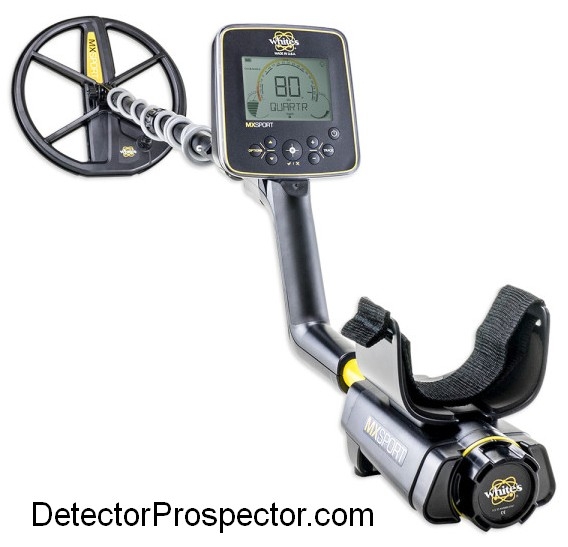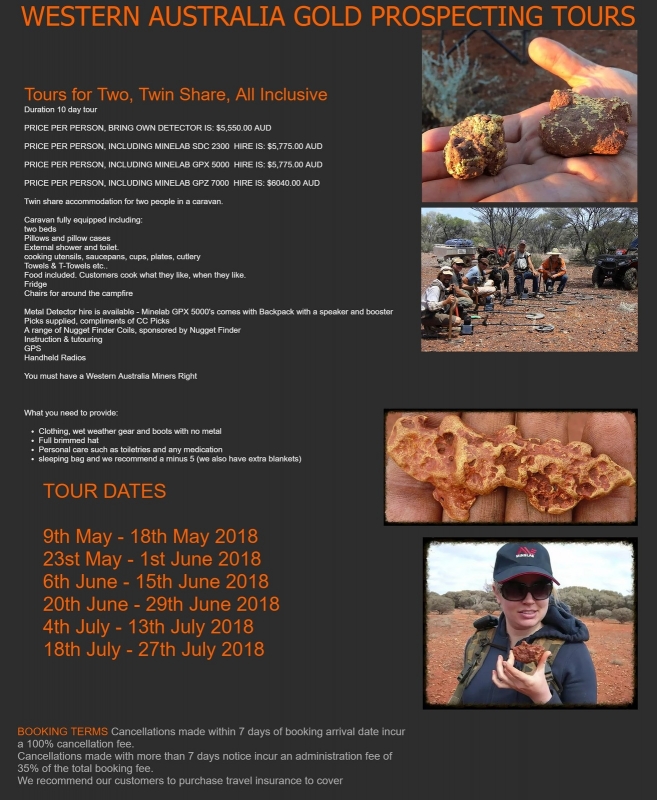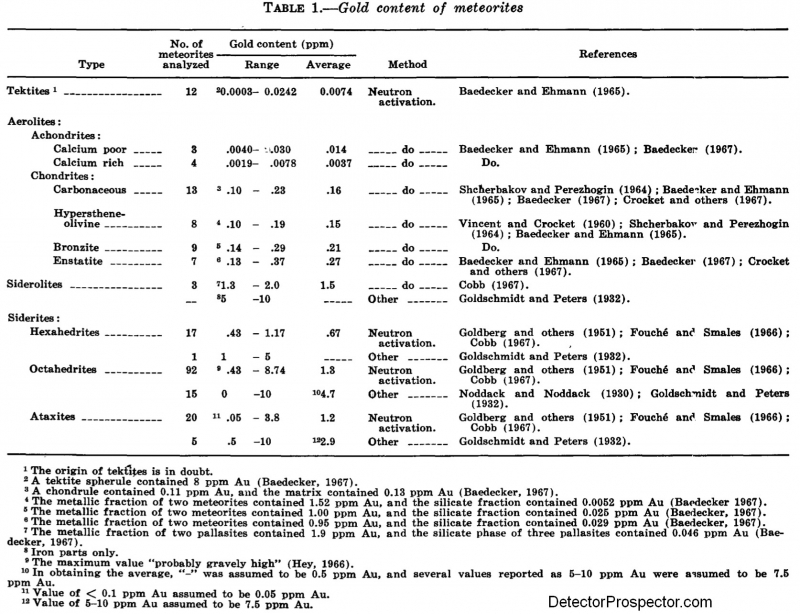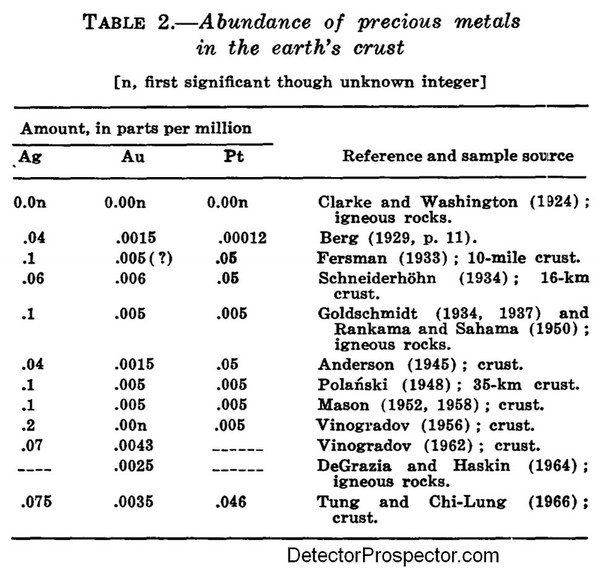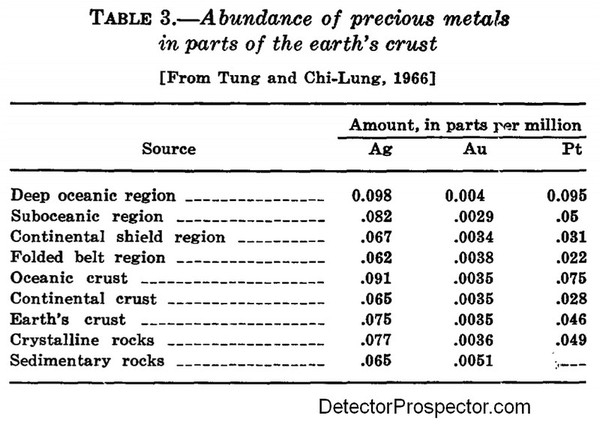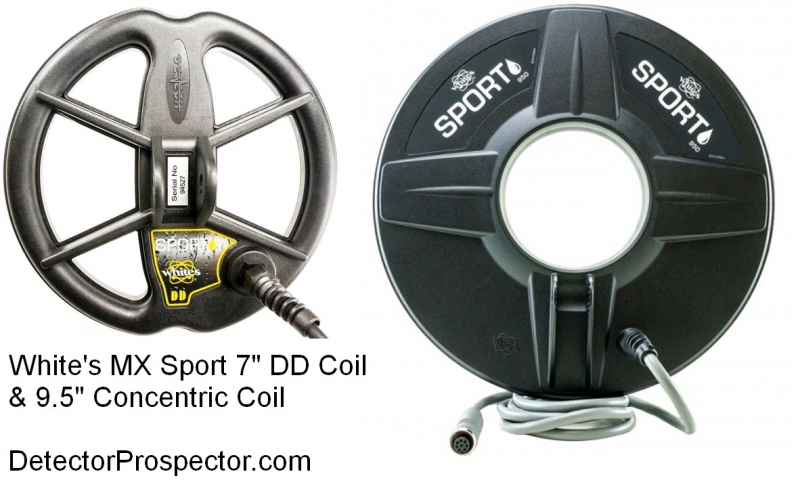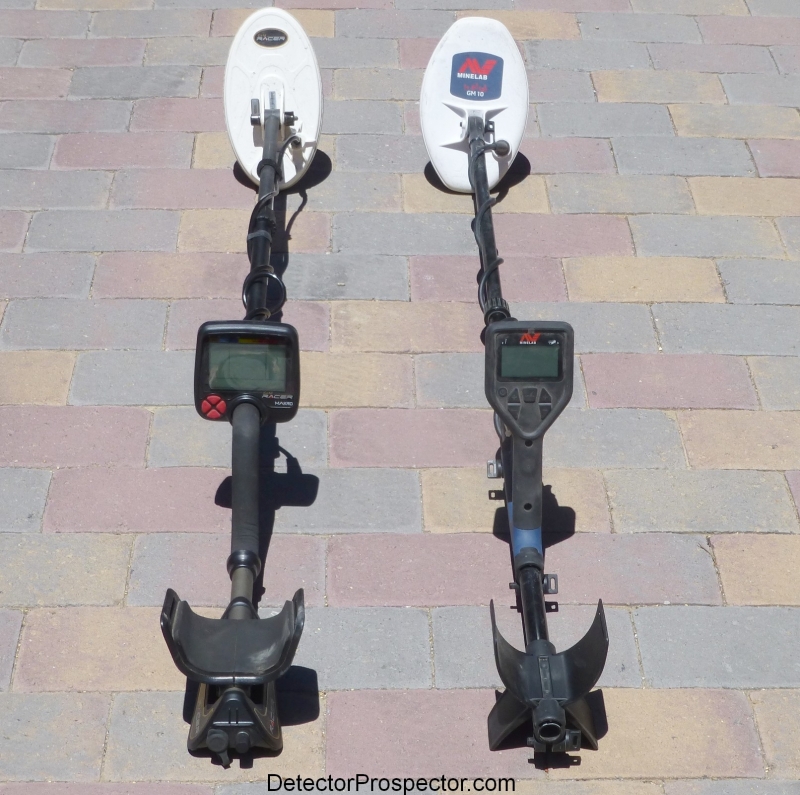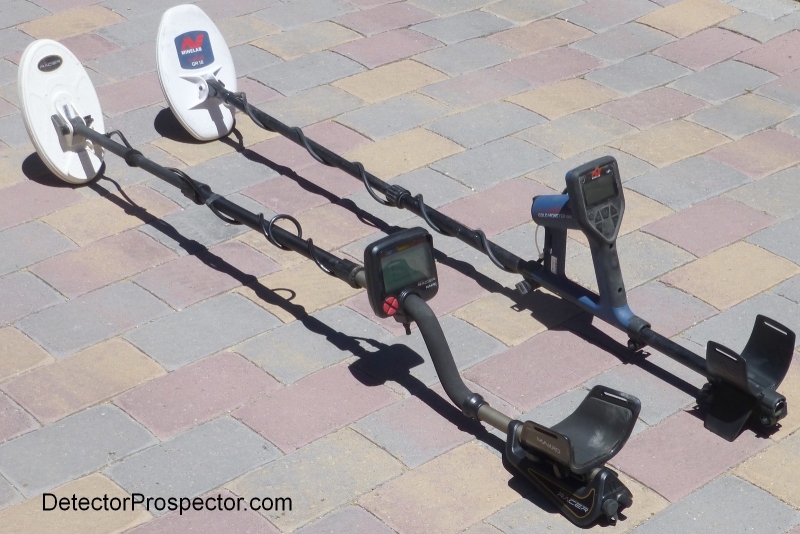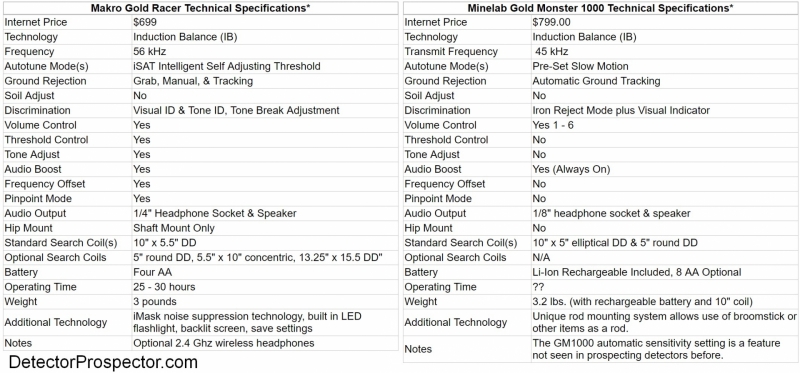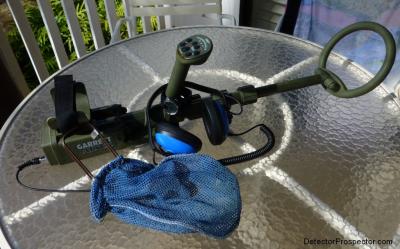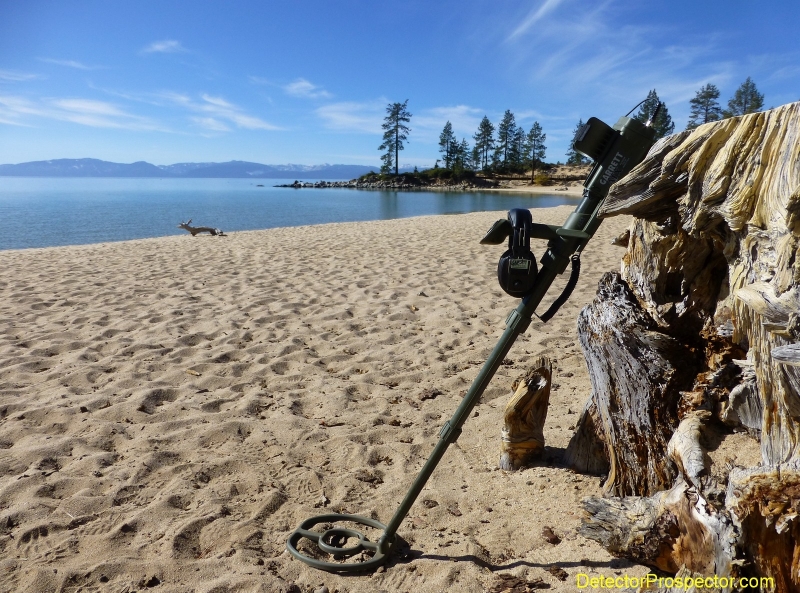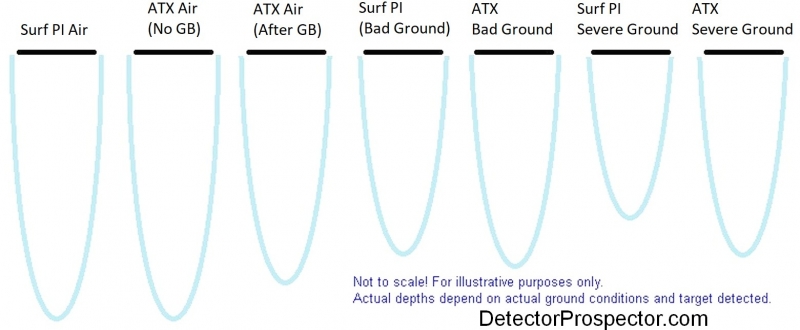-
Posts
19,761 -
Joined
Content Type
Forums
Detector Prospector Home
Detector Database
Downloads
Everything posted by Steve Herschbach
-
Relic mode can be challenging in dense targets. The threshold alerts you to several things. The first of course being that faint increases in the threshold can indicate very deep or very small targets. In a discrimination modes the threshold going away or "nulling" usually indicates you have passed over a target that has been entirely rejected or discriminated out. The threshold can also null if you pass over a streak of black sand or some other ground that is dramatically different that your ground balance setting. If this happens very often where there are no targets you need to adjust your ground balance and possibly sensitivity. Any items in those spots could be missed because nulling due to improper ground balance can suppress good target signals. I hope this helps - good luck!
-

Gold Monster 1000 - My Thoughts
Steve Herschbach replied to SeaScene's topic in Minelab Metal Detectors
Welcome to the forum. Thanks for your thoughts. Hopefully you will hang around and let us know how it all sorts out for you. Good luck! -

Minelab GM 1000 & Makro Gold Racer
Steve Herschbach replied to D&P-OR's topic in Metal Detector Advice & Comparisons
Hi Merton, Sorry so long winded! I don't want to sound like I am avoiding a question but at the same time I am not a big fan of simple answers when reality can be a lot more nuanced. It may prove that the GM 1000 would be a worthwhile investment for you but it's not a slam dunk. People are always going to have their favorites, but as far as I am concerned I can grab any detector running at over 30 kHz and do about as well. The detector will not matter to me much as the quality of the location. -

All Inclusive Oz Gold Tour
Steve Herschbach replied to fredmason's topic in Rocks, Minerals, Gems & Geology
Here is the link direct to their website with 2018 booking dates and costs http://www.gold2r.com.au/wa-tours Copy presented here - click for larger version... -

Minelab GM 1000 & Makro Gold Racer
Steve Herschbach replied to D&P-OR's topic in Metal Detector Advice & Comparisons
The coil touch sensitivity has been mentioned before, though it is hard to get a grip on how bad it is machine to machine. kiwijw's issue in that regard seems more troubling than what I experience, but then again I rarely run the GM1000 at manual sensitivity 9-10. My go-to setting has been manual sensitivity 6, 7, or 8 plus auto sensitivity where needed and at those levels I get no touch sensitivity of note. At 9 I get a little touch sensitivity with both coils, and at 10 it is such that I have to use careful coil control to keep the machine tamed. I have been doing this so long I hardly notice I am doing it but my coil handling with any machine changes almost instantly to whatever the machine tells me keeps it happy. The Gold Racer has some touch sensitivity at max sensitivity also but it is fairly minor. The Gold Bug 2 is the spoiler because you can crank it all the way up and I swear you could play golf with the 6" coil and not get false signals. I use a Gold Bug 2 6" coil to mow dirt flat and push rocks out of the way. You can't do that with the GM1000 at max sensitivity as it will false as you bump and touch things. -

Minelab GM 1000 & Makro Gold Racer
Steve Herschbach replied to D&P-OR's topic in Metal Detector Advice & Comparisons
It's hard to know when klunker is being serious but in this case I totally agree with his answer. If hot ground, laterite soils, and hot rocks are the problem, use a PI. That's the real answer. Which is better though given the specific question (hot ground, laterite, hot rocks), the Gold Racer or GM1000? Short answer - I don't know. For me it's..... well, it's complicated. Here's the story. The main problem for me is that I am finding it increasingly difficult to point at two induction balance detectors ( I can't say VLF because both detectors in question are LF detectors) and declare one is better than the other. IB machines in any given class are extremely competitive given the technology is so old. This means that results are very site specific. The exact mix of ground mineralization and hot rocks varies almost infinitely, and which detector has an edge often depends on the exact location. What is best at Crow Creek, Alaska is probably different than what is best at Rye Patch, Nevada, which is probably different than what is best on serpentine in northern California, which is probably different than what is best in the Bradshaw Mtns of Arizona. And then there is Africa and Australia. The real catch however is what is best for me? The problem I have been facing as of late is that for the last few years something like 98% of my prospecting has been done with a PI detector or more lately the GPZ. Induction balance detectors in my world are second tier prospecting devices for specific problems. That usually means dealing with more trash than I can put up with running a PI or the GPZ. It can also mean wanting extreme sensitivity to tiny bits the GPZ can't hit but I rarely find myself wanting to specifically target tiny wisps of gold these days. The time is better spent going for another larger nugget with the GPZ or ATX. From my perspective that means sorting out which IB detector performs best under circumstances where I would not normally use an IB detector is not a huge priority. As klunker has brilliantly pointed out, the real answer here is "neither". My personal "hot IB (LF 30 kHz plus)" journey goes like this. My first detector in this class was the 50 kHz White's Goldmaster II. It pretty much blew away everything made before, easily besting the 19 kHz Gold Bug of the time for hots on the tiny stuff. Then came the Goldmaster V/SAT and Goldmaster 3. Then around 1995 White's came out with the Goldmaster 4/B which was also about the same time Fisher came out with the 71 kHz Gold Bug 2. White's changed from a small box hip or chest mount style to the coin detector pod type design in the GM4/B, the same as seen in the GMT today. Prospectors hated the new box design (and price increase) and with the new Gold Bug 2 out people switched in droves. I got the first Gold Bug 2 in Alaska and except for brief spells have owned one ever since. Now a Gold Bug 2 convert, I did try the next White's machine, the GMT. The GMT does offer some performance advantages over the Gold Bug 2 (specifically depth in magnetite laden soil) but I never really did take to it, mainly because of the physical design differences between the Gold Bug 2 and GMT. By now I was getting into GBPI (ground balancing pulse induction) detectors and so getting max depth on large gold with an IB detector started to fade as my main concern. Going forward if I wanted depth on large gold I would use a succession of GBPI detectors with IB detectors relegated to situations where either the gold was too small or the trash to dense to use a GBPI. My move from Alaska to Nevada really cemented that situation. I used my Gold Bug 2 a few times to chase small gold in California and then more or less forgot about it as all my gold prospecting was being done with the GPX 5000, SDC 2300, and now GPZ 7000. When I got wind of the Makro Gold Racer I realized I had not turned my Gold Bug 2 on in over two years! The GB2 still has the edge for tiny gold over the Gold Racer, but the extra versatility of the Gold Racer meant I would probably actually use it more, so I sold my Gold Bug 2 at that time and went with the Gold Racer. It was not a bad decision as I did indeed use the Gold Racer more than I would have the Gold Bug 2 due to its full discrimination capability. And when it comes to tiny gold I decided the Gold Racer was "good enough" for my use. This highlights that I am not always looking for extreme performance - overall practicality does matter to me also. Then two things happened. First, XP started making noise about high frequency coil options. I got a Deus in anticipation of what I thought was an imminent release. And hot on the heels of that I got involved in the Gold Monster 1000 project. Since I still think the Gold Bug 2 is the benchmark machine for tiny gold, I bought a used one last year to use for comparative purposes. Now, just so people understand, when prototype testing I am not asked to provide comparative test results or anything like that. The focus is on bug fixing while the engineers worry about squeezing out the performance. Comparative tests are something I do on the side to satisfy my own curiosity. Last winter sucked and the weather did not allow for much detecting at all let alone comparative field testing the way I do it. What few times I could get out it was all focused on final GM1000 checks. My game plan a few months ago was simple. I had my Gold Racer and Gold Bug 2 and now a Gold Monster 1000. I figured I would have my XP HF elliptical coil back in May. I did not want to waste time doing comparative field testing on the three just to have to do everything again when I got the Deus coil so I kept putting that off waiting for the coil. In the meantime I went prospecting in Nevada with my GPZ. This all got complicated by the Nokta Impact also showing up. It is not a LF (30 kHz plus) detector but maxes out at 20 kHz. XP already had me thinking maybe one detector that can switch frequencies was going to be my ultimate answer. The Impact fed into that thinking. The problem for me personally is I am interested specifically in two frequency ranges. Something around 19 khz is going to do well on small gold and also well on larger gold at depth. Something over 30 kHz is going to do better than 19 kHz on tiny gold, but will likely sacrifice some depth on the larger stuff. In my head I am thinking..... XP Deus with 11" round coil at 18 kHz - how does it compare to other detectors in that class? Specifically, the Impact at 20 kHz. And how to judge? I still think the best all around 19 kHz nugget detector is the Gold Bug Pro. Just like the Gold Bug 2 it sets a standard for the class, in both cases because the two models have been in widespread use around the world for many years making them good reference points for others. Then, with my mind bouncing around on selectable frequency, I decided a White's V3i (2.5, 7.5, 22.5 kHz) needed to be added to the mix (out of pure personal curiosity). Now the die was cast for another Darwin's Survival of the Fittest Detector because I was loading up on models with the express purpose of weeding them out. I decided to go for broke and got a killer deal on a new Teknetics G2, which is the same 19 kHz machine as the Gold Bug Pro under a different label. I do not rely on reports from others or videos though they might point me at machines I might be interested in. Once my interest is captured I have to find out what works best for me by getting the machines and trying them. Now, if this makes it seem like I can just afford to blow money like crazy, it generally is a break even proposition for me. Some models come my way via test programs with manufacturers. The rest I buy, either used, like the Gold Bug 2, or get a smoking deal on, like the G2, or via special deals through dealer connections (like my old dealership in Alaska) which is the case with the XP coil and the V3i. My method then is to get the units I am interested in and then I just use them over time and see what happens. I end up using the ones I like and the ones I like less (I actually like them all!) get used less and eventually end up getting sold. That money goes back in the kitty for the next round. So here is my setup scenario: 1. First Benchmark Detector - Fisher Gold Bug 2 at 71 kHz. How does it fare against the 56 kHz Makro Gold Racer (already have a handle on that question), 45 khz Minelab Gold Monster 1000 (already have a fairly good handle on that question), and XP Deus at 74 kHz (not a clue)? 2. Second Benchmark Detector - Teknetics G2 (Fisher Gold Bug Pro equivalent) at 19 kHz. How does it fare against the XP Deus at 18 kHz, Nokta Impact at 20 kHz, and White's V3i at 22.5 kHz. I am going to toss the Minelab CTX 3030 into this mix although as a multifrequency model it does not exactly fit but there is that curiosity thing again. I have one so why not? In a perfect world the XP Deus being able to run at 18 khz and 74 kHz would simply replace all the rest. I suspect it is not going to be that easy. However, when this is all said and done I need to weed it down, and I finally expect to get the new Deus coil next week. Then the games begin in earnest. I have made some decisions so far however. The Minelab GPZ 7000 of all my detectors gets the most use. It stays until something better comes along. The Garrett ATX is the only waterproof GBPI and handles some things my GPZ struggles with, so it also stays put until a better option comes along. I have bounced between the White's DFX and V3i ever since the V3i came out. As a detector nerd I decided the V3i represents a unique piece of technology that is unlikely to be surpassed when it comes to the ability to customize every variable possible in a detector. It took awhile but I finally decided to get a new latest version full warranty V3i and keep it as the first entry in my new "permanent collection". The DFX is for sale in the Classifieds right now. After going without for almost two years, I found I missed that Gold Bug 2 as I played around with the used one I got. I decided to make it the second entry in my permanent collection and just got a new latest version full warranty Gold Bug 2. The used one is for sale in the Classifieds right now. I am here: 1. Minelab GPZ 7000 - Main gold prospecting unit for most situations. 2. Garrett ATX - Main saltwater jewelry detector; backup for GPZ 7000; some coin detecting. 3. Fisher Gold Bug 2 - Only detector I have used for over twenty years, deserves a place in my collection just for that. But still tops for flyspeck "scrape and detect" operations and wisps of gold in quartz. 4. White's V3i - Nothing else like it really, a detector nerd's dream and an engineering tour de force. Also a fantastic urban jewelry detector, one of the best ever made for that purpose, especially when paired with a Bigfoot coil. And that leaves me with this mess to sort out: 1. Makro Gold Racer 2. Minelab CTX 3030 3. Minelab Gold Monster 1000 4. Nokta Impact 5. Teknetics G2 6. XP Deus Out of those the CTX is almost certain to survive. I honestly would kind of like to see the Deus knock the rest off but I am skeptical. OK Merton, if you are still with me, here is what I think/guess at the moment. First, I can't say for sure because I have been waiting for the XP coil to show before making some specific trips to specific situations chosen just to help me sort this all out. A couple of those are extreme ground situations but trash handling in California nail pits does matter to me also. I do think if the ground is super bad you are better off using a PI or a GPZ and so personally I will admit there is a certain "good enough" aspect to all this and what I personally am looking for is a best overall combination of performance factors combined with personal preference issues like feel on my arm and how the audio pleases me, etc. My impression of the Makro Gold Racer is that while it is not quite as hot as a Gold Bug 2 6" coil combo on very tiny gold, it is very close. It is however very finicky in real bad ground/hot rocks and getting the right combination of tuning options can be a challenge, and not one I swear to have mastered. The Gold Bug 2 by comparison is easier to operate, in part simply by having fewer options. The Gold Monster 1000 has taught me however that part of my problem running a Gold Racer is I push the sensitivity way too high, then fight the effects of running it too hot. I really need to back down on the sensitivity. My educated guess at the moment is that the 45 khz Gold Monster 1000 will more easily handle bad ground, but only with the caveat that it also can suffer from running the sensitivity too high. The question is that if I am on serpentine bedrock in California, ground full of magnetite, hot rocks all around, how the GM 1000 and Gold Racer compare? That is going to depend largely on how high you can push the sensitivity on both units and still get stable operation. I can pretty much bet the GM1000 will be easier to handle, but only by going full automatic. My main concern with the GM1000 is it either works or does not because there really is nothing to adjust. Ground tracking is automatic so you just have to trust it. That leaves sensitivity and disc mode as the only two things you can adjust to deal with bad ground and hot rocks. Disc mode robs a good chunk of the performance, as does auto sensitivity, though in the worst ground you may need one or both options to cope. In all metal, manual sensitivity, you will light up hot rocks etc. and the coil will get knock sensitive at higher levels (manual 9-10). The Gold Racer has some coil knock issues but the GM1000 is worse if you push both hard. All that long winded explanation boils down to my thinking the Minelab Gold Monster 1000 is going to have the edge in the worst ground for dealing with the mineralization and hot rocks, and I am placing my bet there mainly based on my faith in Minelab's automatic ground balancing technology. In other words, if I was headed to that nasty serpentine magnetite laden hot rock infested spot in California right now and had to choose between the Makro Gold Racer and the Minelab Gold Monster 1000 I would grab the GM1000. Reminding you of course of what you already know - a PI is a better option. So why take a VLF? Maybe the spot is full of nails and tin cans. Now the discrimination aspects kick in. I normal ground, the Gold Racer slays the GM1000 for discrimination. The Gold Monster is a preset iron disc with no ability to adjust. In severe ground however discrimination suffers greatly and becomes quite unreliable except on very strong targets, and the disc capability gap probably narrows. At the end of the day it comes down to this. The Minelab Gold Monster 1000 was built with only one idea in mind. Getting decent performance out of a hot induction balance machine in real bad ground (i.e. Australia) whereas the Gold Racer does have a more general purpose intent. Minelab does enjoy an advantage being based in Australia when it comes to perfectly machine for use in tough conditions. In keeping with my advice on dedicated versus general purpose I am therefore going to bet overall on the Minelab Gold Monster 1000 versus the Makro Gold Racer for extreme ground handling capability while gold prospecting. That's all it is however, a bet based on limited data points and so I could be wrong. I will know a heck of a lot more on the subject in about two months. Until then, maybe Nenad in Australia or somebody else that has both machines can enlighten both of us more on the subject. klunkers answer is not only better, but far more to the point! -
It should be since that was your 30th post! There is no perfect answer. The ten post limit will basically prevent many honest people from dropping by and possibly offering us a very good deal. However, this makes it a service that is more exclusive to forum members. I have a couple sidebars that advertise the Classifieds on all the forums so you do not need to visit the Classifieds to see the latest. Just watch the sidebars. However, they are space limited and too many people posting ads drives longtime member ads off the sidebars too quickly. Anyway, ten it is.
-
Gold in Meteorites and in the Earth's Crust, U.S.G.S Circular 603 by Robert Sprague Jones, 1968 Original pdf https://pubs.usgs.gov/circ/1968/0603/report.pdf ABSTRACT The reported gold contents of meteorites range from 0.0003 to 8.74 parts per million. Gold is siderophilic, and the greatest amounts in meteorites are in the iron phases. Estimates of the gold content of the earth's crust are in the range of 0.001 to 0.006 parts per million. INTRODUCTION This report is one of several that summarize available data on the occurrence of gold. They have been prepared as background material for the Heavy Metals program of the U.S. Geological Survey, an intensified program of search for new sources of heavy metals, including gold. Data on the occurrence of gold in meteorites and tektites are summarized, and recent estimates of the abundance of gold in the earth's crust are compiled. GOLD IN METEORITES Table 1 shows reported gold contents of tektites, aerolites, siderolites, and siderites. The table is arranged so that the data on tektites, which have the lowest iron contents, are at the top of the table and the data on siderites, which have the highest iron contents, are at the bottom. The other meteorite groups are intermediate in iron contents except for the siderolites. Gold is most abundant in the siderites and least abundant in the tektites; therefore, meteorites supply good evidence of the siderophilic character of gold. The tektites and the achondrites are relatively low in gold contents and are distinct from the other groups of meteorites in this respect. The gold contents of tektites and achondrites are of the same order of magnitude as those of terrestrial rocks. The other meteorites, on the average, contain appreciably more gold. Although the iron contents of meteorites are similar in many respects to those of mafic and ultramafic rocks, the meteorites tend to contain much more gold. In chondrites, the gold seems to be almost entirely in the dispersed metallic phase (Vincent and Crocket, 1960), and this is probably true of the other meteorite. The gold content of the metallic phase of the chondrites is about 1.4 ppm (parts per million), which is similar to the gold contents of siderolites, octahedrites, and ataxites (Vincent and Crocket, 1960; Goldberg and others, 1951). The carbonaceous chondrites are primitive, relatively undifferentiated matter from which the other meteoritic types have evolved (Mason, 1962; Baedecker and Ehmann, 1965). The occurrence of gold in such primitive types may be of special interest. The average gold content for 13 carbonaceous chondrites is 0.16 ppm, an amount greater than that in the average terrestrial rock by a ratio of about 40 to 1. It has been suggested (Aller, 1961) that the best approximation to the average composition of the earth's mantle or even the entire earth is provided by the composition of the chondrites. They are similar in chemical composition to the ultramafic rocks, and their isotopic constitution for several elements is basically the same as that for the rocks of the mantle. Baedecker and Ehmann (1965) shew the abundances of gold, iridium, and platinum in four groups of chondrites. In the olivine-bronzite (H group), the olivine-hypersthene ( L group), and the carbonaceous chondrites, the abundance ratio of Pt :Ir :Au is approximately 7-9:2:1; but for the enstatite chondrites, gold is more abundant and the Pt :Ir :Au ratio is 3.5:0.2 :1. The iridium shows a relatively large decrease with respect to gold. These values, however, represent only analysis of the Abee enstatite chondrite made by Baedecker and Ehmann (1965) by neutron-activation methods. Analysis of this same meteorite by Crocket and others (1967), who also used neutron-activation methods, gives a somewhat different relationship. Their ratio for Pt :Ir :Au is 5.9 :1.5:1. The amount of platinum, iridium, and gold reported by Baedecker and Ehmann is 1.3, 0.083, and 0.37 ppm, respectively; Crocket and others reported 1.3, 0.32, and 0.22 ppm, :respectively. The iridium-gold ratio of terrestrial rocks is more like that of tektites than it is like the ratios of the other meteorites (Baedeckler and Ehmann, 1965). The gold contents of the octahedrites do nott seem to vary with the coarseness of the octahedrites. Cobb (1967) noted that most of his valules for gold in meteorites were in the range of 0.2 to 2.5 ppm. Cobb (1967) and Goldberg, Uchiyama, and Brown ( 1951) analyzed parts (three in all) of the same meteorite, and Cobb obtained lower values. The average values of gold in hexahedrites were also low compared with those of Goldberg, Uchiyama, and Brown (1951). For the same 11 meteorites analyzed by neutron-activation methods by Goldberg, Uchiyama, and Brown (1951) and Fouche and Smales (1966), the average contents were 1.1 ppm gold and 0.9 ppm gold, respectively. The various types of siderites have differing amounts of gold. Ataxites and octahedrites have an average gold content of ab1ut 1.3 ppm, which is about twice that for hexahedrites (0.64 ppm). The hexahedrites usually have less nickel than either the ataxites or the octahedrites. The Santa Catharina ataxite contained the most nickel ( 38.5 percent) and r.lso the most gold (4.0 ppm), but the Deep Springs ataxite (13.4 percent nickel) contained the least amount of gold (less than 0.1 ppm, but considered as 0.05 ppm for table 1). Fouche and Smales (1966) analyzed 70 siderites and found gold contents that ranged from 0.055 to 3.61 ppm. The correlation coefficients between gold and rhenium and between gold and chromium were low and negative, giving values of -0.41 and - 0.31, respectively, but the correlation between gold and arsenic was +0.82 and between gold and palladium +0.68. Goldschmidt and Peters (1932) analyzed the Coahuila, Mexico, meteorite and reported that it contained 1 to 5 ppm gold, whereas analysis by the neutron-activation method by Goldberg, Uchiyama, and Brown (1951) gave 0.743 ppm gold; by Fouche and Smales (1966), 0.70 ppm gold; and by Cobb (1967), 0.43 ppm gold. Goldschmidt and Peters (1932), analyzed the Mount Joy, Pa., meteorite and reported that it contained 5 to 10 ppm gold, whereas analysis by the neutron-activation method by Goldberg, Uchiyama, and Brown (1951) gave 0.994 ppm gold. These comparative values along with others in this report seem to indicate that lower values are obtained for gold when neutron-activation methods are used. ESTIMATES OF GOLD IN THE EARTH'S CRUST Parker (1967) has pointed out the difficulty in estimating the composition of the earth's crust, which forms less than 1 percent of the earth's mass (Aller, 1961). Differences among the estimates given by various authors since Clarke and Washington (1924) are due partly to different concepts of what constitutes the earth's crust, the depth to the Mohorovicic discontinuity, the composition of the oceanic crust compared with the continental crust, and the changes in crustal composition with depth. Also, with respect to gold specifically, the newer method of analysis, that of neutron activation, has resulted in a general downward revision of gold values. Table 2 gives the various estimates for the abundance of the precious metals, gold, platinum, and silver, in the earth's crust. Precious metal contents of various parts of the earth's crust has been noted by Tung and Chi-Lung ( 1966). These data are given in table 3. The estimates of gold and silver in the earth's crust have varied little since those of Clarke and Washington in 1924, although the estimates for platinum have varied substantially. The Ag :Pt :Au ratios, based on Tung and Chi-Lung's (1966) figures, are 21 :13:1. REFERENCES CITED Aller, L. H., 1961, The abundance of the elements: New York, Interscience Publishers, 283 p. Anderson, J. S., 1945, Chemistry of the earth: Royal Soc. New South Wales Jour. and Proc., v. 76, p. 329-345 . Baedecker, P. A., 1967, The distribution of gold and iridium in meteoritic and terrestrial materials: U.S. Atomic Energy Comm. [Pub.] OR0-2670-17, and Ph.D. thesis, Univ. Kentucky, 110 p . Baedecker, P. A., and Ehmann, W. D., 1965, The distribution of some noble metals in meteorites and natural materials: Geochim. et Cosmochim. Acta, v. 29, p. 329-342. Berg, Georg, 1929, Vorkommen und Geochemie der mineralischen Rohstoffe : Leipzig, 414 p. Clarke, F. W., and Washington, H. S., 1924, The composition of the earth's crust: U.S. Geol. Survey Prof. Paper 127, 117 p. Cobb, J. C., 1967, A trace-element study of iron meteorites: Jour. Geophys. Research, v. 72, no. 4, p. 1329-1341. Crocket, J. H., Keays, R. R., and Hsieh, S., 1967, Precious metal abundances in some carbonaceous and enstatite chondrites: Geochim. et Cosmochim. Acta, v. 31, p. 1615-1623. DeGrazia, A. R., and Haskin, Larry, 1964, On the gold content of rocks: Geochim. et Cosmochim. Acta, v. 28, p. 559-564. Fersman, A. E., 1933, Geokhimiya, Tom 1: Leningrad, 328 p. Fouche, K. F., and Smales, A. A., 1966, The distribution of gold and rhenium in iron meteorites: Chern. Geology, v. 1, no. 4, p. 329-339. Goldberg, Edward, Uchiyama, Aiji, and Brown, Harris~n, 1951, The distribution of nickel, cobalt, gallium, palladium, and gold in iron meteorites: Geochim. et Cosmochim. Acta, v. 2, p. 1-25. Goldschmidt, V. M., 1934, Drei Vortage uber Geochemie: Geol. Foren. Stockholm For h. v. 56 p. 385-427. ---1937, Geochemische Verteilungsgesetze der Elemente. IX. Die Mengenverhaltnisse der Elemente und der Atom-Arten: Norske Vidensk.-Akad. Oslo, Skr., Matematisk-Naturvidenskapelig Kl., 1937, no. 4, 148 p. Goldschmidt, V. M., and Peters, Cl., 1932, Zur Geochemie des Edelmetalle: Gesell. Wiss. Gottingen, Nachr., Math.-Phys. Kl., no. 4, p. 377-401. Hey, M. H., 1966, Catalogue of meteorites: British Mus. (Nat. History) Pub. 464, 637 p. Mason, Brian, 1952, Principles of geochemistry: New York, John Wiley and Sons, 276 p. ---1958, Principles of geochemistry [2d ed.] : New York, John Wiley and Sons, 310 p. ---1962, Meteorites: New York, Joln Wiley and Sons, 274 p. Noddack, Ida, and Noddack, Walter, 1930, Die Haufigkeit der chemischen Elementen: Naturw., v. 18, p. 757-764. Parker, R. L., 1967, Composition of the earth's crust: U.S. Geol. Survey Prof. Paper 440-D, 19 p. Polanski, Antoni, 1948, A new essay of evaluation of the chemical composition of the earth: Soc. Amis Sci. et Lettres Poznan Bull., Ser. B., v. 9, p. 25-46. Rankama, Kalervo, and Sahama, Th. G., 1950, Geochemistry: Chicago, Univ. Chicago Press, 912 p. Schneiderhohn, Hans, 1934, Die Ausnutzungsmoglichkeiten der deutschen Erlagerstatter : Metallwirtschaft 13, p. 151-157. Shcherbakov, Yu. G., and Perezhogin, G. A., 1964, Geochemistry of gold: Geochemistry Internat., no. 3, p. 489-496. Tung, Li, and Chi-Lung, Yio, 1966, The abundance of chemical elements in the earth's crust and its major tectonic units: Scientia Sinica, v. 15, no. 2, p. 258-272. Vincent, E. A., and Crocket, J. H., 1960, Studies in the geochemistry of gold. II. The gold content of some basic and ultrabasic rocks and sto:-1e meteorites: Geochim. et Cosmochim. Acta, v. 18, p. 143-148. Vinogradov, A. P., 1956, Regularity of distribution of chemical elements in the earth's crust: Geokhimiya, translation, no. 1, p. 1-43. ---1962, Average content of chemical elements in the principal types of igneous rocks of the earth's crust: Geokhimiya, translation, no. 7, p. 641-664.
-

Jerry Keene Passes Away
Steve Herschbach replied to Reno Chris's topic in Gold Panning, Sluicing, Dredging, Drywashing, Etc
Thanks for letting us know Chris. Jerry indirectly had a great impact on my life in several ways. I will send my condolences directly to the family but I certainly want to express them here also. May he rest in peace. -
The White's MX Sport comes with an epoxy filled DD coil that does not float when submerged. The main issue with the 950 (9.5") round concentric is that it is foam filled and so buoyant in the water. It will however pinpoint easier and help with difficult ferrous targets like bottle caps. Depth can be as good as the stock coil in milder ground but as the ground mineralization gets worse the stock DD coil with have an advantage. The 7" DD is made by DeTech and is epoxy filled so no issues with being submerged. It will pinpoint easier just due to being smaller and of course will not cover as much ground. Depth will be lost compared to the stock coil in mild ground. However, in really bad soil the depth can be surprising because the smaller coil "sees" less ground volume and so can still come very close to the stock coil for performance in the worst ground.
-

Minelab GM 1000 & Makro Gold Racer
Steve Herschbach replied to D&P-OR's topic in Metal Detector Advice & Comparisons
Makro Gold Racer - Target ID, full range discrimination, steeper learning curve. Bottom line? Better for somebody looking for a more general purpose machine (gold, coins, jewelry, relics) that is very hot on gold. Minelab Gold Monster 1000 - No target ID, no adjustable discrimination. Ease of use a priority. Bottom line? Better for somebody looking for a gold prospecting specific detector with possible jewelry applications (dry beach, tot lots). My general recommendation is if you only want to prospect for gold, then use a detector made expressly from the ground up for that purpose. If you want a detector to do more than just prospecting, get a general purpose detector that is hot on gold. I have both and neither is going away anytime soon. Click images below for larger views... -

Which Mono Coil For Infinium?
Steve Herschbach replied to MontAmmie's topic in Garrett Metal Detectors
I like the 8" mono personally and now that I have the ATX an 8" mono for it has been my favorite coil for in water use. It is light and maneuverable making it fun to use, with the bonus of easy pinpointing. Air test of 8" mono versus stock coil.... http://www.treasurenet.com/forums/garrett/353994-infinium-ls-air-test-8-mono-vs-10-x-14-dd.html -

Which Mono Coil For Infinium?
Steve Herschbach replied to MontAmmie's topic in Garrett Metal Detectors
I faced the same quandary with my Infinium. The 14" mono adds a small amount of depth and is a little lighter than the stock coil. The 8" mono however packs surprising bang for the size and actually gets better depth on many targets. John did a test with a chart at Link deleted since Findmall Forum update broke all old links but the chart has gone missing - here is a copy I archived... -
Welcome to the forum! What you are doing is working so I am not one to say you need to run out and get another detector. What specifically is the problem with the Lobo you are hoping to solve with another detector? If I was raking tailings for little gold and quartz bits I would probably be using a Gold Bug 2 with 6" coil, just because it will hit harder on tiny bits than the Lobo. If you are having difficulty detecting really hot mineralized ground or dealing with real bad hot rocks a PI might be in order. These days instead of the ATX ($2120) I am more inclined to aim a person at the GPX 4500 ($2699) for just a little more money, unless you need the waterproof feature. Neither the ATX or GPX is likely to help you out much with the rake and detect operation however. They are better suited for general prospecting. The thing about rake and detect is depth is not really an issue since you are bringing the material closer to the coil. If you did decide to get an ATX get the new version with the 11" x 13" enclosed DD coil.
-

What You Need To Know About The Scuba Tector
Steve Herschbach replied to Ridge Runner's topic in Quest Metal Detectors
Here is the video.... I can't say I am surprised. This is a PI pinpointer set to ignore salt water, so gold sensitivity would be impacted. Still, it looks worse than one would expect. It hits rings better simply because a ring in a loop of metal. Any ring like item (steel washer) with produce a better signal with a metal detector because they create a good circular path for eddy currents by essentially mimicking the loop of metal in your metal detector searchcoil. Chains on the other hand are notoriously hard to detect because of the loose connection between links. A detector is more prone to seeing each link as a separate item than a continuous mass, making detection difficult. Why Won't My Detector Find A Bottle Full Of Small Nuggets? Or A Gold Chain? -

Keene Mini Max
Steve Herschbach replied to Triplehooked's topic in Gold Panning, Sluicing, Dredging, Drywashing, Etc
Each of those little 500gph bilge pumps draws about 2 amps. A good deep cycle battery should give you about 20 - 25 hours running time. Great little unit, just a modified A52 sluice. The only catch is with the small GPM delivered by the bilge pumps you have to baby the feed compared to what you can do with the same sluice using a good stream flow to supply the water. -
When I created the Metal Detecting & Prospecting Classifieds the forum was smaller and less busy. I set it up initially so that any forum member can post in the Classifieds. So far that has worked well, or at least I have had no complaints. However, I am seeing a definite uptick in the number of people who join the forum for the sole purpose of placing an ad. This is in theory a good thing - new forum members! Unfortunately it does mean people with no forum history at all can place an ad one minute after joining, and that invites scammers. I have therefore just added a provision whereby only forum members who have made at least two posts on other forums can place an ad in the Classifieds. This is a free service intended for forum members in good standing, and a benefit for active, posting members. That provides for at least a minimal level of protection from someone trying to scam other forum members. I will generally be able to spot people who join and make a couple worthless posts for no other reason than to bump the count to place an ad. Anyway, this is kind of provisional, and I can remove the requirement, or make it more difficult by raising the post requirement even higher. The bottom line is if everyone is very careful to properly vet potential purchases this is not necessary, but I do worry a bit about somebody being taken advantage of and want to do what is reasonable to try and prevent that without being too draconian. Am I being to paranoid? Everyone comfortable with it the way it has been? Or is a post limit a good idea? Thoughts, opinions, feedback?
-
The ATX will work for you just fine in Florida but I just would not expect any real depth advantage, if any, over the Surf PI. The noise at the end of swings is normal if the machine is picking up the salt - it is worse walking parallel to shore and reduced if you walk straight to the water and then straight away. So work the beach up and down instead of side to side, if you know what I mean. It is possible to not ground balance the ATX and run sensitivity high, but you have to use careful coil control to manage the undesired sounds. One advantage with an ATX is the tones can sometimes be used to advantage, as can the iron disc for shallow ferrous items like bobby pins. The entire reason for a ground balancing PI (GBPI) however is in the advantage ground balancing offers in real bad ground. You just happen to be in one of the few locations in the world where magnetic ground mineralization is rare to nonexistent. So yeah, I am a huge ATX fan but if I was headed to Florida tomorrow I would be packing my CTX.
-

What's Your Pleasure In Batteries
Steve Herschbach replied to Ridge Runner's topic in Metal Detector Advice & Comparisons
I am guessing most of us got burned by Ni-Cad batteries. I don't know how many of them were going to save me money, but got tossed as going bad on the shelf over the winter or whatever. My DFX right now has a White's Ni-Cad system that is pretty much useless the life is so short. I use the standard AA pack and use separate rechargeable NiMH batteries instead. There is a lot to be said for going that way as I can toss and replace individual cells as they go bad. New battery systems are far better now and I am finally starting to trust them more. I think most normal detectorists can do just fine now with built in rechargeable batteries like what we see in the Deus. Use detector by day, charge at night. Prospecting however involves remote locations, sometimes for long periods, and running your detector dead is no good unless you can slap another battery pack in and get on with business. My GPZ pretty much runs all day and gets charged each night, but I would not be comfortable without that spare battery in my kit - just in case. I lean a bit more to the White's style drop in battery as opposed to the Minelab clip on battery, simply because the White's system protects the expensive battery more. Something like a waterproof detector however does really benefit from a built in sealed battery. The best part will be when wireless charging comes to detectors, eliminating the need for a charger connection. This would help make waterproof detectors less leak prone. -
Great stuff Harry congratulations! Any story here at all? Was this something you researched in advance, anticipated, hunted down and found? Or more just a lucky find while doing the general detecting thing? Gold Bug 2? Thanks for posting!
-
Welcome to the forum! First off, your mention of "drift" does not seem right - you may have a defective detector. Drift in my book means you tune up the detector, and if you leave it sitting on the ground and walk away, the tuning slowly changes all by itself. This is usually seen by the threshold getting slowly louder until it becomes very loud. Or, the threshold fades away until it disappears. Any modern detector operating properly should hold a steady threshold after tuning. Now, if you are tuning up your machine in one spot, then when you move it it starts to make sounds, then the detector may simply not be tuned properly. For starters, your sensitivity level may be too high for salt water operation. Florida generally has a higher salinity level than some other places and so the salt water itself is a problem, though the ATX should still ground balance it out. If you read the link posted above however you will see it takes me a combination of lower sensitivity, increased disc, and ground balancing to tame the salt water and volcanic rocks in Hawaii. The first goal is to get stable operation. I have a very hard time explaining to people that PI detectors in particular and ground balancing in general do not "add depth" or "go deeper". Due to the point of diminishing returns the fact is most good high power metal detectors with an identical coil will find a metal object in an air test at roughly the same distance. This is the theoretical 100% max depth as revealed in air tests. It is the theoretical maximum distance into the ground that you might find the same item in the ground. The problem is metal detectors also pick up both magnetic type soils and salt water. If the detector is seeing these things it blinds them to the metal object you wish to find. The classic example is car headlights in the dark. When the air is clear you can use high beams and see a great distance. However, if the air is full of heavy rain or snow, the headlights reflect off these undesired targets and blind the driver. The solution? Low beams. Less power focused more directly in front of the car removes the excess feedback from the rain/snow allowing you to see that deer standing in the road. Ground balancing is a filter and not all that different that the way the discrimination system works. The ground signal or salt signal (or both) are identified and then tuned out. The ground effect is still there, but the detector subtracts it from the overall signal. The key word there is "subtracts". Ground balance methods work by subtracting part of the signal, and all subtractive methods create depth losses of some sort the closer any detected item gets to the "hole" created by subtracting the ground or salt signal. Signals are not perfect but spread over a small range, and so eliminating any signal usually means taking out a small range of signals. If you have a trash target like a bottle cap and a high resolution detector that bottle cap will produce a VDI (Visual Display Indicator) number or target id number. If you try to disc just that one number, you will still usually get a broken signal, because the bottle cap actually produces a small range of numbers that dance around as you sweep the coil over it repeatedly. To reject the bottle cap completely means possibly having to eliminate a range of several VDI numbers. The catch? Any good items with similar numbers will also be rejected along with the bottle cap. Items that read just one or two VDI numbers in either direction may also see degraded results. Ground balance works the same way. A window of response is rejected. Desired tems that fall into or near that same signal response area see reduced depths or are eliminated. Luckily most desired items do not fall into the same region as most ground signals. Eliminating slat signals has more direct impact because small gold signals and salt signals are identical. The ground balance is a filter that is applied to the signal and depending on the efficiency of the method used, there is almost always some degradation of all target signals as compared to a metal detector running in a pure all metal mode with no ground balancing at all as measured in air tests. The White's TDI illustrates this perfectly. Turn of the ground balance and air test a nickel. No simply turn on the ground balance, and air test the same nickel. There will be an immediate loss of depth simply by engaging the ground balance filter. The amount of dpeth lost will vary depending where the ground balance control is set. The closer to the nickel reading the ground balance setting gets, the weaker the signal on the nickel itself. Normally a ground balance gets set to whatever the ground demands, but in low mineral ground there is a lot of leeway, and knowing which way to go with the ground balance control on the TDI can enhance certain signals and degrade others. Sorry for the long winded explanation but this is hard stuff to get across in words. For the grand finale consider the White's Surf PI Dual Field and the ATX. The Surf PI does not ground balance at all. The ATX does ground balance, but immediately after a factory reset the filter is at the minimum level or as close to neutral as possible, although I do not think it can be considered to be completely off. But for the purposes of this discussion let's assume that is the case. In the diagram above: 1. Surf PI Air and ATX Air (No GB) - here we are assuming we have found an item that the Surf PI and ATX with no ground balance applied both see at identical distance in an air test. Both units are seing 100%. 2. ATX Air (After GB) - now we ground balance the ATX and air test our item again. We note that after ground balancing the very same item cannot be detected as far in an air test as before ground balancing. This is because the filtering effect has removed some depth. In this case if detecting in pure white sand, little or no mineralization, the Surf PI will get more depth that a ground balanced ATX. In very low mineral ground, like in Florida, the ATX will perform best with no ground balancing. Now, from a practical perspective when dealing with salt water you have a problem. The Surf PI is a pure PI detector with a pulse delay specifically chosen to ignore salt water effects. The machine is inherently insensitive to salt signals and small gold. The ATX is much hotter on small gold, and so will pick up salt water easily. This means that just to get in saltwater you have to lower the sensitivity, or increase the disc setting, or ground balance the ATX to the salt water, or some combination of the three. So while in theory the ATX is hotter on small gold than the Surf PI, just to get in saltwater you have to engage filters to bring the ATX small gold sensitivity down to Surf PI levels so as to ignore the salt signal. 3. Surf PI (Bad Ground) and ATX (Bad Ground) - Now we are on a beach that has quite a bit of darker soil content along with some magnetic soil properties. The Surf PI has no ability to ground balance or tune out this soil, and so it is getting lots of ground signals. The only way the machine can cope is lower receiver sensitivity or increased pulse delay, which lowers sensitivity a different way, plus careful coil control. Quite a bit of dpeth is lost. Note the ATX also loses depth in this scenario, but because the detector can be ground balanced, it does not lose as much depth. Let me repeat that, it is so important. The ATX succeeds here, not by going deeper, but by losing less depth. This is a critical difference in how people think about metal detectors. people always think in terms of "getting more depth" when a more accurate way to think about it is to think in terms of "losing less depth" as compared to air test theoretical 100% maximums. It is not the detector that gets the most depth that wins, but the detector that loses the least depth. This may seem like two ways to say the same thing but it is not. It is why I tend to have so little regard for air tests. Air tests do have value in showing what could be the max 100% depth an item can be found at in perfect conditions. However, what is far more important is how much of that depth is retained under adverse conditions, i.e. in the ground or in salt water. Anybody can make a detector that air tests great. The Surf PI is a simple easy to make in your garage circuit and it air tests fine. Yet it will not do as a gold prospecting detector since it completely lacks any ability to ground balance and so gives up nearly all ites performance in extremely mineralized ground. Which brings us to... 4. Surf PI (Severe Ground) and ATX (Severe Ground) - I am actually being too generous with the Surf PI here as in bad ground it could be running at 50% or less of its theoretical max obtainable air test on a buried item in severe ground, with the ATX getting under to double or more depth that the Surf. Yet do note that the ATX has lost depth also - it just does not lose the depth as quickly or as severely because it has the ground balance circuit working for it hard, trying to retain depth under adverse conditions. The Surf I under such conditions is at distinct disadvantage. So, two detectors, the Surf PI (pure PI) and ATX (Ground Balancing PI). The less mineral content in the ground, the better the Surf PI looks, and so Florida, especially the Florida Keys, is the ideal situation for the Surf PI since Florida soil runs from very low to almost zero magnetic mineral content. The ATX looks better and better by comparison as ground mineralization increases. West coast and especially Oregon and Washington type black sand salt water beaches are the ground that suits the ATX best. Not because it gets more depth than the Surf PI, but because the ATX will lose far less depth under those conditions when properly ground balanced. I hope this helps as it is a difficult subject to communicate.
-

White's Dfx Versus V3i On Gold
Steve Herschbach replied to Steve Herschbach's topic in White's Metal Detectors
I have extreme respect for teachers (my wife is one) so that is a high compliment indeed. Thank you sir! -

White's Dfx Versus V3i On Gold
Steve Herschbach replied to Steve Herschbach's topic in White's Metal Detectors
The Prospecting Scan (Alluvial Scan) is, as far as I can tell, a continuous graphic display of the ground phase which is the same thing as a ground balance setting. It is showing you the TYPE or ground mineralization, not the AMOUNT of ground mineral. See here for reference. Low numbers are salt ground and higher numbers ferrous ground. In theory tracking to more mineralized ground looking for black sand concentrations, on the theory those concentrations will have gold associated. The reality is this function in a normal metal detector is so depth limited that it is debatable whether eyeballs looking for color variations might be the better tool. -

White's Dfx Versus V3i On Gold
Steve Herschbach replied to Steve Herschbach's topic in White's Metal Detectors
We are all learning here! What makes true manual ground balance different is that the control simply spans the entire available ground balance range. This range does vary a lot in detectors. Anyway, you just put the control where you want, and most owner manuals tell you a good default setting. The only way to properly ground balance a manual unit is to manipulate the control in reference to audio feedback you get when bouncing the coil about 8-12" over the ground. Some places have no magnetic ground content (Florida white sand beach) against which to ground balance, so you dial in the default value instead. At a certain level metal detector targets exist in reference to and in opposition to the ground balance setting. Performance degrades as the target VDI (phase) gets closer to the ground balance VDI (phase). In some circumstances you can purposefully move the ground balance setting away from the targets electronic reading and enhance the target signal by doing so. The White's TDI, even though it is a PI, is a machine that demonstrates well the effect of ground balance on desireable targets. Another oddball use - splitting the difference between the ground balance setting for the ground itself, and a particular pesky hot rock. A person can usually operate with a bit of positive offset anyway. Moving the ground balance point closer to where a hot rock reads and away from the ground will increase ground noise but decrease the intensity of the hot rock "hit". Lower Gain, increased SAT, and splitting the GB setting can all help make hot rocks less obtrusive or even eliminate them entirely. Long story short, there are reasons to manually mess with the ground balance.

